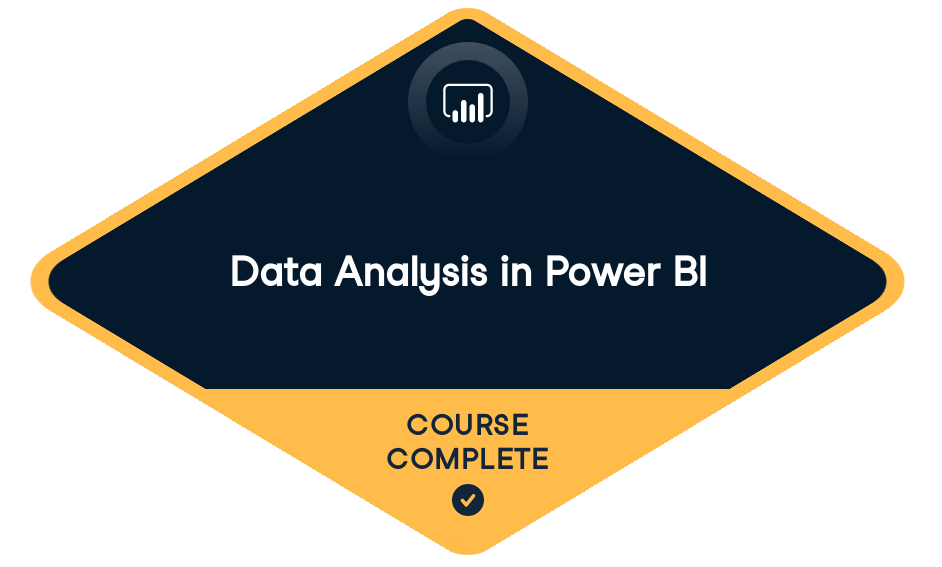
Loved by learners at thousands of companies
Course Description
Enhance your reports with Power BI's Exploratory Data Analysis (EDA). You'll start by using descriptive statistics to spot outliers, identify missing data, and apply imputation techniques to fill any gaps in your dataset. You’ll then learn how EDA in Power BI can help you discover the relationships between variables—both categorical and continuous. You'll also learn how to analyze time series, visualize your data, and spot trends. Lastly, you’ll find out how to identify which variables exhibit the most influence on the target variable using Power BI's decomposition trees and key influencers.This course will be split into two smaller courses of 3 hours on Tue 26 April in light of a brand-new Power BI track! Course completion will be transferred to these two new courses, so please complete the course in due time. Alternatively, you can wait a few days until the new courses are live!
Training 2 or more people?
Get your team access to the full DataCamp platform, including all the features.- 1
Initial Exploratory Data Analysis in Power BI
FreeYou’ll begin this Exploratory Data Analysis (EDA) course by learning how to use descriptive statistics, identify missing data, and apply imputation techniques to fill the gaps in your data. You’ll also build histograms to analyze distributions and use winsorizing to remove outliers.
What is exploratory data analysis?50 xpSteps to EDA100 xpInitial EDA of AirBnB listings50 xpIdentify missing data100 xpDescriptive statistics for a variable100 xpImputation for missing data100 xpDistributions and outliers50 xpChoices for finding outliers50 xpHistograms and outliers in AirBnB listings50 xpCreate your first histogram100 xpIdentify outliers100 xpAddressing outliers in the data100 xp - 2
Exploring Relationships Between Variables
Now it’s time to explore the relationships between categorical variables using proportions. You’ll then use box plots and descriptive statistics to determine how a continuous variable is influenced by a categorical one. Finally, you’ll dive into scatter plots to analyze the relationship between two continuous variables and calculate the correlation coefficient.
EDA with categorical variables50 xpHistograms vs. box plots100 xpExploring categorical variables with AirBnB data50 xpAnalyzing a categorical variable100 xpProportions with categorical variables100 xpAnalyzing multiple categorical variables100 xpCreating a box plot100 xpRelationships between continuous variables50 xpPractice interpreting a scatter plot50 xpExploring AirBnB listings with scatter plots50 xpAnalyzing relationships with scatter plots100 xpAdding context to scatter plots100 xpCorrelation coefficient100 xp - 3
Analyzing Time Series in Power BI
In this chapter, you’ll get more familiar with time-based variables and the multiple ways to extract further variables using EDA for analysis—like day of week and time difference. You’ll get hands-on with Power BI as you build line charts to calculate new metrics and uncover trends hiding in your data—including period-over-period change and rolling averages.
Starting to explore time series data50 xpStatements about time series analysis50 xpExploring AirBnB time series50 xpGenerating a new date variable100 xpAnalyzing trends by day of week100 xpCalculating year-over-year change100 xpTime series run chart50 xpCyclical vs. Seasonal100 xpAnalyzing Glassdoor reviews over time50 xpBuilding your first time series chart100 xpCalculating rolling averages100 xpFinding anomalies in time series data100 xp - 4
Identifying Important Variables for an Outcome
One of the most powerful functions of EDA in Power BI is being able to identify which variables have the most influence on your target outcome. To do this you’ll get to grips with two of Power BI’s native visualizations—Decomposition Trees and Key Influencers. First, you'll learn about Decomposition Trees, how to construct, then interpret in order to explain a target outcome by other variables. Finally, you will build a Key Influencers visual, leveraging machine learning, to understand how much a target outcome changes based on specific variables and segments of observations.
Introduction to decomposition trees50 xpStatements about decomposition trees50 xpUsing decomposition trees in Power BI50 xpGetting started with decomposition trees100 xpDiving deeper into decomposition trees100 xpDecomposing attrition rates100 xpIntroduction to key influencers50 xpDecomposition trees vs. key influencers100 xpUsing key influencers in Power BI50 xpKey influencers for average listing price100 xpSegments from key influencers100 xpKey influencers for super hosts100 xpCongratulations!50 xp
Training 2 or more people?
Get your team access to the full DataCamp platform, including all the features.datasets
Exercises and Datasourcescollaborators

Senior Content Developer at DataCamp
Maarten is an aquatic ecologist and teacher by training and a data scientist by profession. He is also a certified Power BI and Tableau data analyst. After his career as a PhD researcher at KU Leuven, he wished that he had discovered DataCamp sooner. He loves to combine education and data science to develop DataCamp courses. In his spare time, he runs a symphonic orchestra.
Data Scientist at Microsoft
Jacob H. Marquez is an insatiable learner and lifelong builder. He is a data scientist by day, answering audacious questions to support customer experience and company goals. He is a serial hobbyist by day and night: being an educator, building a coffee recommendation app, drinking coffee, writing on Medium, and amateur cycling and muay thai. He has a bachelor's in psychology and a master's in computational analytics (2024).
Join over 18 million learners and start Data Analysis in Power BI today!
Create Your Free Account
or
By continuing, you accept our Terms of Use, our Privacy Policy and that your data is stored in the USA.